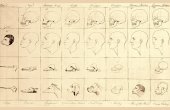What the National Review Gets Wrong About Deconstruction

The monuments of Western literature came tumbling down long before confederate statues. In fact, a baffling article recently published in the National Review goes as far as to suggest that the root cause of “cancel culture” can be attributed to efforts to deconstruct the literary canon and its traditions. These efforts, argues the author, took up residence at elite institutions of higher education in the late 20th century and empowered generations of students to multiply, go forth, and make the world “woke.”
What the article gets right is that deconstruction was specifically formulated to confront the venerable monuments of Western thought with an explicit challenge and alternative way of thinking that contests the status quo. What it gets wrong, like so many other complaints before it, is the assumption that any challenge like this must be negative and the epitome of a youthful nihilism run amok. Nothing could be further from the truth.
I can’t think of a better time to revisit and more accurately define the concept of “deconstruction” and its significance.
Deconstructing Deconstruction
The word “deconstruction,” despite initial appearances, does not indicate “to take apart,” “to un-construct,” or “to disassemble.” Despite this widespread and rather popular misconception, which has become something of an institutional (mal)practice in both the popular and academic press, deconstruction is not negative. As Jacques Derrida, the progenitor of the concept, emphasized on more than one occasion: “Deconstruction, let’s say it one more time, is not demolition or destruction.”
Deconstruction is a kind of “thinking outside the box” that exceeds the grasp of the existing conceptual order.
But to declare that deconstruction is not negative does not mean that it is something positive either. “The de- of deconstruction,” Derrida explains, “signifies not the demolition of what is constructing itself, but rather what remains to be thought beyond the constructionist or destructionist schema.” Deconstruction, then, seeks to identify a third alternative. It is a kind of “thinking outside the box” that exceeds the grasp of the existing conceptual order.
This is because deconstruction works as a corrective to the binary oppositions that organize common ways of thinking; it’s a complex, rigorous approach to critical thinking that can’t be reduced to a buzzword. We typically make sense of ourselves and our world by deploying sets of binary oppositions — good/bad, white/black, right/left, male/female, mind/body, etc. The underlying logic of this way of thinking is the principle of non-contradiction. This principle, sometimes called the “law of non-contradiction,” has been, at least since the time of Aristotle, perhaps the defining condition of Western thought. As proof of this, we only need to consider what has already transpired here: We have employed the law of non-contradiction in the very process of characterizing deconstruction by way of distinguishing it from what it is not.
The Principle of Non-Contradiction
Binary oppositions are undoubtedly useful and expedient. They not only help us make sense of the world; they appear to be a fundamental principle of thought itself. Despite this, there are profound systemic problems.
On the one hand, binary oppositions restrict what is possible to know and to say about the world and our own experiences. Opposites push things toward the extremes. As the late literary critic Barbara Johnson insightfully wrote in her book “A World of Difference,” “If not absolute, then relative; if not objective then subjective; if you are not for something; you are against it.” Although this kind of exclusivity has a certain functionality and logical attraction, it’s often not entirely in touch with the complexity and exigency of things on the ground. It’s for this reason that we are generally critical of “false dichotomies” — the parsing of complex reality into a simple either/or distinction. The current political situation, which has been described as “more polarized than ever,” stands as just one instance or symptom of this problem.
On the other hand, these conceptual opposites arrange and exert power. For any logical opposition or binary pairing, the two items are not typically situated on a level playing field; one of the pair has already been determined to be the privileged term. Or as Derrida explains, “we are not dealing with the peaceful coexistence of a vis-à-vis, but rather with a violent hierarchy. One of the two terms governs the other (axiologically, logically, etc.), or has the upper hand.”
Rather than simply tearing down the monuments of the past and leaving them in ruins, deconstruction provides students with the tools for remixing the past for the sake of shaping the future.
Conceptual oppositions, then, are neither neutral nor objective. As the science and technology scholar Donna Haraway argues, “certain dualisms have been persistent in Western traditions; they have been systemic to the logics and practices of domination of women, people of color, nature, workers, animals — in short, domination of all constituted others, whose task it is to mirror the self.” Dualisms, then, are expressions of power. They are always and already hierarchical arrangements that are structurally biased. And it is this skewed hierarchical order that installs, underwrites, and justifies systems of inequality, domination, and prejudice.
So what does this have to do with dismantling the monuments of Western literature and ‘wokeness’? The troubling dualisms that are the critical target of deconstruction do not just float around in the ether; they take form and are formalized in texts. The “great books” of Western philosophy, literature, and science utilize and codify these conceptual formations and therefore stand as solid monuments to a particular way of seeing, thinking, and acting in the world. Deconstruction empowers students to confront, question, and critically respond to these conceptual formations. Rather than simply tearing down the monuments of the past and leaving them in ruins, deconstruction provides students with the tools for remixing the past for the sake of shaping the future.
There are, then, good moral and political reasons to question the hegemony of conceptual oppositions and to challenge the usual and inherited structural arrangements. As Hannah Arendt writes, “We all grow up and inherit a certain vocabulary. We then have got to examine this vocabulary.” And deconstruction names not just the examination of vocabulary but a general strategy for seeing, thinking, and doing otherwise.
Two Steps to Deconstruction
The deconstructive effort begins by deliberately overturning the two terms that make up an existing conceptual order. This “flipping of the script,” or what Derrida also describes as “bring low what was high” is, quite literally, a revolutionary gesture. But inversion, in and by itself, is not sufficient. It is only half the story. Revolutionary inversion — whether it be social, political, or philosophical — actually does little or nothing to challenge or change the existing system of power. In merely exchanging the relative positions occupied by the two opposed terms, inversion still maintains the binary opposition in which and on which it operates — albeit in reverse order or upside-down. Simply turning things around is necessary but not sufficient.
Deconstruction provides a way forward into possible futures that are not beholden to a repetition of what has gone before.
For this reason, deconstruction necessarily entails a second phase or operation. “We must,” as Derrida describes it, “also mark the interval between inversion, which brings low what was high, and the irruptive emergence of a new ‘concept,’ a concept that can no longer be, and never could be, included in the previous regime.” This “new concept” that is the product of the second phase occupies a position that is in between or at the margins of a traditional, conceptual opposition or binary pair. It is simultaneously neither-nor and either-or.
Perhaps the best example and illustration of this two-step operation is available with the term “deconstruction” itself. In a first move, deconstruction flips the script by putting emphasis on the negative term “destruction” as opposed to “construction.” In fact, the apparent similitude between the two words, “deconstruction” and “destruction,” is a deliberate and calculated aspect of this effort. But this is only step one — the phase of inversion. In the second phase of this double gesture, there is the emergence of a new concept. The novelty of this concept is marked, quite literally, in the material of the word itself. “Deconstruction,” which is fabricated by combining the de– of “destruction” and attaching it to the opposite term “construction,” produces a strange and disorienting neologism that does not fit in the existing order of things. This new concept, despite first appearances, is not negative. It is not the mere opposite of construction; rather, it exceeds the conceptual order instituted and regulated by the opposition situated between construction and destruction. “It is only on this condition,” Derrida concludes, “that deconstruction will provide itself the means with which to intervene in the field of oppositions that it criticizes.”
Thinking Otherwise
I can already hear the complaints and moans of the skeptics — skeptics like those given voice by the National Review: What’s the point? Why mess with the status quo when everything seems to be working just fine? Or perhaps even more critical: Isn’t this kind of mental gymnastics just an exercise in navel contemplation reserved for privileged elites?
This last item is less a question and more of a containment strategy. What those in power want and need is for this kind of academic super-power to be restricted and locked-up in ivory towers. They know that problems begin when this stuff gets out in to the world and starts making trouble. And deconstruction is, if nothing else, another name for “making trouble.” Although informed by and made possible through a direct engagement with the literary monuments of the past — a veritable who’s who of dead white male authors — deconstruction provides a way forward into possible futures that are not beholden to a repetition of what has gone before.
So go ahead, blame deconstruction for the social, political, and cultural transformations breaking out all over the place. That’s the point.
David J. Gunkel is Distinguished Teaching Professor of Communication Technology at Northern Illinois University and the author of, among other books, “The Machine Question: Critical Perspectives on AI, Robots, and Ethics,” “Robot Rights,” and the forthcoming (Fall 2021) “Deconstruction,” in the MIT Press Essential Knowledge series.



